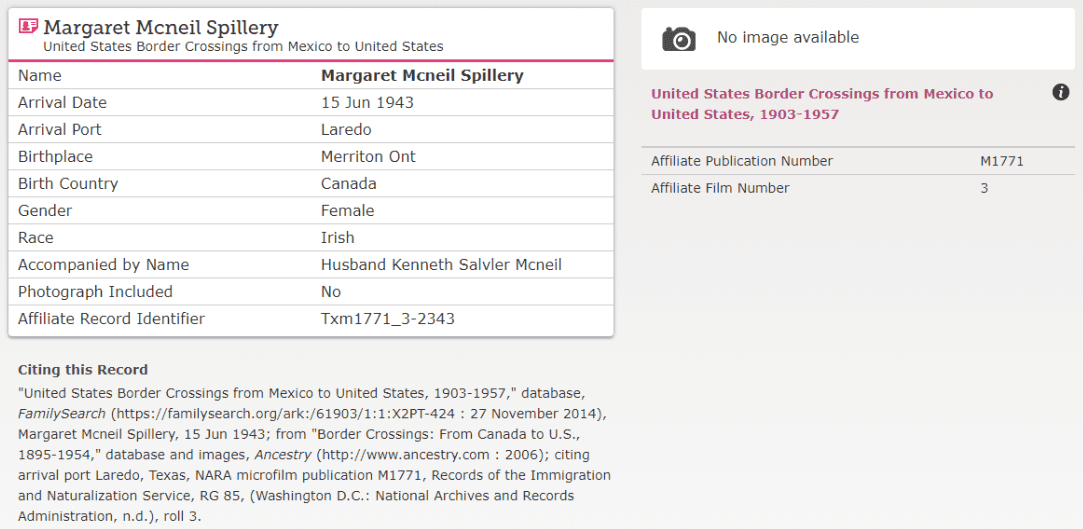Introduction: In this article – part of an ongoing “Introduction to Genealogy” series – Gena Philibert-Ortega writes about records that were kept of people of all nationalities who crossed the Mexican/U.S. border, beginning in 1895. Gena is a genealogist and author of the book “From the Family Kitchen.”
Ship passenger lists are an important resource for the family historian tracing an immigrant ancestor. It should be no surprise that people living in Mexico and Canada have historically crossed back and forth into the United States as they searched for work, visited with family, vacationed, or shopped. United States residents have also done the same, maybe even frequently if they lived in a city close to the border. People from all over the world used the Mexican border as a way to enter the United States.
Did your 20th century ancestor cross the border from Mexico into the United States? Mexican border crossing records can provide much-needed details about your ancestor that are absent in other sources.

Information Available
Records documenting those crossing the United States/Mexican border were not kept until 1895 because early U.S. immigration acts did not require gathering statistical information at the land border. In addition, the purpose for immigration control at the Mexican border was initially not to stop illegal immigration, but instead to “record the names of immigrants and assure they met health standards.” (1)
Mexican border crossing records are similar to ship passenger lists, with some exceptions. Information on the border crossing cards includes:
- Name
- Age
- Sex
- Marital status
- Occupation
- Point of arrival
- Final destination
More than one form was used to collect information at the border crossing, and each form recorded different information. More or less all cards include name, age, marital status, and occupation. In some cases, you may even be rewarded for your research efforts with a photo of your ancestor.
Form 621 is one example of the type of information available on a border crossing record. It included:
- Name
- Marital status
- Occupation
- Ability to read and write
- Last and future place of residence
- Amount of money brought with them
- Port of entry
- Who they are joining in the U.S.
- Physical characteristics (height, complexion, hair and eye color)
- Place of birth
- Nationality
- Who accompanied them
These border crossing records are a great resource, providing not only genealogically relevant information about an individual ancestor but, potentially, other family members as well.
It’s obvious that you might use these records to find your Mexican ancestors crossing into the United States. But remember that it is a border crossing, which means that people of other nationalities and citizenships, including U.S. citizens, Latin Americans, Europeans, and Asians may be found in these records. These records document people coming to the U.S. for all kinds of reasons, from those who frequently crossed to those who may have crossed into the United States only once because they were traveling.
Didn’t Record Everyone
Now, the downside to these border crossing records is that not everyone crossing the border was counted and recorded. Until 1930, those who had lived in Mexico for a year and planned to be in the United States for less than six months, were not counted. According to the National Archives, those who were documented from 1930-1945 include: (2)
- Those who had not been in the U.S. within six months, who came to stay more than six months
- Those for whom straight head tax was a prerequisite to admission, or for whom head tax was specially deposited and subsequently converted to a straight head tax account
- Those required by law or regulation to present an immigration visa or reentry permit, and those who surrendered either, regardless of whether they were required by law or regulation to do so
- Those announcing an intention to depart from a seaport in the United States for Hawaii or other insular possession of the U.S., or for a foreign country, except arrivals from Canada intending to return there by water
- Those announcing an intention to depart across the other land boundary
To learn more about who was and wasn’t counted, see the National Archives’ article, Mexican Border Crossing Records.
Where Are the Records?
Before you seek out these records, it’s important to keep in mind that while National Archives has records for border crossings in Arizona, California, New Mexico, and Texas, genealogy websites with this collection may not cover all of these ports or the range of years the records were kept. To research the entire collection, you will need to use the records available from the National Archives itself.
Border crossing records are U.S. federal records and as such are in the custody of the National Archives (RG 85: Records of the Immigration and Naturalization Service).
One of the places you can find some of these records is FamilySearch. FamilySearch’s online collection is currently an index and does not include the California ports. Remember that this is simply an online index and will not contain all of the information found on these records. A chart showing what is available from FamilySearch can be found on the FamilySearch Research Wiki article, U.S. Immigration Mexican Border Crossings.
You can read more about the records at the FamilySearch Research Wiki page for the collection.
I also recommend reading the web page Mexican Border Crossing Records from the National Archives.
Start Your Search
Our ancestors traveled for work, family, and fun. Keep in mind that whether they had family in Mexico or not, your ancestor may have crossed the border into the United States – and if so, federal records may have documented their trips, providing you with genealogical information not found elsewhere.
____________________
(1) George & Peggy Ryskamp’s Finding Your Mexican Ancestors (Ancestry Publishing, 2007).
(2) “Mexican Border Crossing Records,” National Archives (https://www.archives.gov/research/immigration/border-mexico: accessed 29 April 2019).
